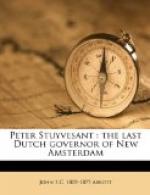Mr. Brodhead, in his admirable History of the State of New York, says,
“The flag of England was, at length, triumphantly displayed where for half a century that of Holland had triumphantly waved; and from Virginia to Canada, the king of Great Britain was acknowledged as sovereign. Whatever may have been its ultimate consequences, this treacherous and violent seizure of the territory and possessions of an unsuspecting ally, was no less a breach of private justice than of public faith. It may indeed be affirmed that, among all the acts of selfish perfidy which royal ingratitude conceived and executed, there have been few more characteristic and none more base.”
Thus the Dutch dominion in North America passed forever away. I cannot refrain from quoting the just tribute to the Dutch government contained in Mr. Brodhead’s History. “Holland,” he writes,
“has long been the theme for the ridicule of British writers; and even in this country the character and manners of the Dutch have been made the subjects of an unworthy depreciation. Yet, without undervaluing others, it may confidently be claimed that, to no nation in the world is the Republic of the West more indebted than to the United Provinces, for the idea of the confederation of sovereign States; for noble principles of constitutional freedom; for magnanimous sentiments of religious toleration; for characteristic sympathy with subjects of oppression; for liberal doctrines in trade and commerce; for illustrious patterns of public integrity and private virtue, and for generous and timely aid in the establishment of independence. Nowhere among the people of the United States can men be found excelling in honesty, industry, courtesy or accomplishment, the posterity of the early Dutch settlers of New Netherland.”
Soon after the surrender, Governor Stuyvesant was recalled to Europe to vindicate his conduct. The severest charges were brought against him. He addressed to the States-General an “Account of the Circumstances preceding the surrender of New Netherland.” It was a triumphant vindication of his conduct. But the unfortunate are rarely treated with justice. The pride of Holland was deeply touched by the loss of its North American possessions. Governor Stuyvesant soon returned to New York, and lived in much seclusion in his spacious house on his farm, until he died, in the year 1672. The governor’s remains were entombed at his chapel in the Bouwery, now St. Mark’s Church.
There were two roads which led from the fort at the Battery, to the northern part of the island. One of these followed along the present line of Broadway to what is now the Park, which was at that time a large unenclosed open field far out of town called the Common. The road then wound along by the southeastern side of the common and by the line of Chatham street and the Bouwery out to Harlaem. This became eventually the “Old Post Road”




